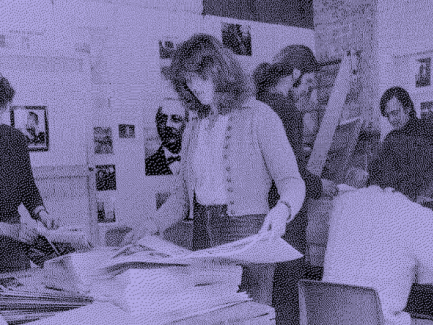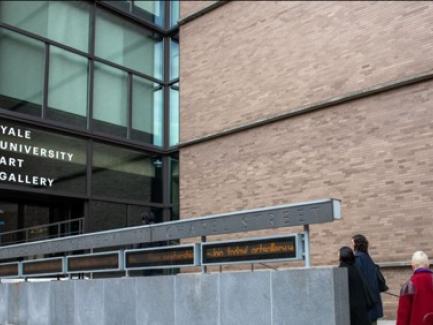Six works by Marc Quinn are displayed in juxtaposition with the museum's historic collections.
NEW HAVEN, CT (May 10, 2022) — Over his career, Marc Quinn (b. 1964) has produced a diverse body of work that forms meaningful connections with art history and reflects on human experience. Quinn seeks to make sense of the world by focusing on ideas about science, mortality, survival, and the environment. From May 20 through October 16, 2022, the Yale Center for British Art presents Marc Quinn: History Painting +. Six works, including the artist’s modern history paintings, are shown in juxtaposition with paintings by Thomas Gainsborough, Joshua Reynolds, and J. M. W. Turner.
“Marc Quinn offers a contemporary comment on the British artistic traditions, such as landscape and history painting, which are well-represented in the museum’s collection,” said Courtney J. Martin, Paul Mellon Director, Yale Center for British Art. “Placed in dialogue with eighteenth- and nineteenth-century paintings and sculptures, his work directly engages our historic collections, offering new perspectives on these works and expanding the comprehension of our collection for a wider audience.”
The exhibition begins in the Entrance Court with Self 1991 (1991), the first in a sculptural series wherein medium, material, and message collide. Cast from a mold taken directly from the artist’s head, the work is made from ten pints of his blood—roughly the same volume that circulates through the human body. For Quinn, the use of blood enables him to create a higher level of portraiture, in which his likeness is composed of a part of his own body. Described by the artist as a “sculpture on life support,” Self relies on constant refrigeration to maintain its form. A metaphor for human fragility and physical deterioration, it both evokes and upends the traditional role of the portrait bust as a symbol of immortality. Created through a process similar to cryopreservation, the sculpture serves as a reminder of how one objective of art, particularly classical portraiture, is to conserve the legacy of an individual beyond their death and decay.
On the fourth floor, four works from Quinn’s History Painting series are displayed alongside the YCBA’s historical collections. “The core of the series is about overturning art historical tropes,” Quinn explained. Traditional history paintings fictionalized depictions of contemporary events to glorify nation and empire. In Quinn’s History Painting series, the artist inverts the genre by foregrounding civilians engaged in anti-government protests around the world. His photo-realist canvases reimagine iconic images from Associated Press, Getty, and Reuters, such as Vasily Maximov’s photograph of the burning “battlefield” of Kyiv for Time magazine in 2014, and Jonathan Bachman’s photo of Ieshia Evans facing police in Baton Rouge following the killing of Alton Sterling in 2016. Because of wide-scale media distribution, images of ordinary people take on immense and unprecedented political agency and power.
Over a decade in the making, each painting in the series is carefully developed over a course of months, in contrast to the rapid circulation of the images from which they derive. Each canvas is finished with gestural overpainting, using the same colors with which the picture was made. This final creative step encapsulates the energy of the process and expresses the latent, unlimited potential of paint, in its raw and abstract form, to become any image or depict any event. The combination of hyperrealism and abstraction speaks to the interplay between order and chaos, materialization and dematerialization.
“Marc Quinn’s meticulously executed paintings completely transform our relationship with familiar news images,” noted Martina Droth, Deputy Director and Chief Curator, Yale Center for British Art. “We often think of news as momentary, but these paintings occupy a different temporal space. They monumentalize and amplify world-shifting events, which speaks to the power of images to resonate across time and new contexts.”
The exhibition also features Thames River Water Atlas (2017), a medium-scale sculpture that Quinn conceived as an artist’s book. Similar to many objects in the museum’s collec-tions, the work considers humanity’s relationship with and impact on the environment. It incorporates traces of detritus found at the edges of the Thames and impressions of water drains in London’s streets, marking a vivid contrast with the land and seascapes on display at the YCBA. This freestanding sculptural work was published by Ivorypress, which has specialized in artists’ books for twenty-five years.
Marc Quinn: History Painting + was organized in collaboration with the artist and curated by Martina Droth, Deputy Director and Chief Curator, Yale Center for British Art.
Exhibition Brochure
Read more about the objects on view in the display.
Related Programs
Exhibition Opening Conversation
Friday, May 20, noon | Lecture Hall
Artist Marc Quinn talks with Martina Droth, Deputy Director and Chief Curator at the Yale Center for British Art. This program is livestreamed.
Timothy Snyder, Post-Colonial Ukraine: The Meanings of Resistance
Friday, June 3, noon
In History Painting (Kiev [Kyiv], 22 January 2014) YGORBW, Quinn depicts the deadly clashes between protestors and police that devastated Kyiv in 2014. As war is waged across Ukraine, the city has once again become a battlefield. Timothy Snyder, Richard C. Levin Professor of History at Yale University, provides historical context for the current conflicts. This program is livestreamed.
About Marc Quinn
Born in London in 1964, Quinn is a British contemporary artist and one of the leading artists of his generation. His sculptures, paintings, and drawings explore what it means to be human in the twenty-first century, connecting frequently and meaningfully with art history, from antiquity to modern masters. Quinn came to prominence in 1991 with his sculpture Self (1991), a cast of the artist’s head made from ten pints of his frozen blood. While much of his early work focused on explorations of self, Quinn became fascinated with reflecting the experiences of other people, questioning value, perception, and the fault lines of society. Critically acclaimed works include Alison Lapper Pregnant (2005), exhibited on the Fourth Plinth of London’s Trafalgar Square; Siren (2008), a solid-gold sculpture of Kate Moss shown in the British Museum coinciding with the 2008 financial crisis, that poses questions of value and belief systems in society; Breath (2012), a colossal replica of Alison Lapper Pregnant, commissioned for the 2012 London Paralympics opening ceremony; and Self-conscious Gene (2019), an eleven-foot, six-inch tall bronze sculpture of Rick Genest, popularly known as Zombie Boy, now on permanent display at the Science Museum, London. Over the last decade, Quinn’s work has increasingly engaged with the media, current affairs, and world events. Quinn’s work is included in collections around the world, including the Centre Pompidou, Paris; Fondazione Prada, Milan; Guggenheim Museum, New York; Tate, London; the Metropolitan Museum of Art, New York; SFMOMA, San Francisco; and the Stedelijk Museum, Amsterdam. He lives and works in London.
Quinn currently has two other exhibitions on view. The National Archaeological Museum of Venice is presenting his latest series, HISTORYNOW, through October 10, 2022. Derived from Quinn’s iPhone screenshots, the works are exhibited in dialogue with the museum’s collection from classical antiquity, creating a commentary on the speed and media with which humans have communicated throughout history. Quinn’s early sculptural series Emotional Detox is on view at the Belvedere Museum in Vienna, Austria, through July 3, 2022, alongside the iconic “character heads” by Franz Xaver Messerschmidt. The eighteenth-century artist’s work has long been an inspiration to Quinn and directly influenced this series.
About the Yale Center for British Art
The Yale Center for British Art (YCBA) houses the largest collection of British art outside the United Kingdom, encompassing works in a range of media from the fifteenth century to the present. The museum offers a vibrant program of events and exhibitions year-round in person and online. Opened to the public in 1977, the YCBA’s core collection and landmark building—designed by architect Louis I. Kahn—were a gift to Yale University from the collector and philanthropist Paul Mellon (Yale College, Class of 1929). Visit the YCBA at britishart.yale.edu and connect on Facebook, Twitter, Instagram, and YouTube @yalebritishart.
Media Kit
Download our document and images related to this exhibition.


